Mechanical and Tribological Performance of Additively Manufactured Nanocrystalline Aluminum via Cryomilling and Cold Spray
Abstract
1. Introduction
2. Materials and Methods
2.1. Materials
2.2. Sample Preparation
2.2.1. Cryomilling
2.2.2. High-Pressure Cold Spray (HPCS)
2.3. Mechanical Testing
2.4. Pin on Disk Tests
Estimation of Wear Volume, Wear Rate, and Wear Coefficients
2.5. Material Characterization
2.5.1. X-Ray Diffraction
2.5.2. Microscopic Characterization
3. Results and Discussion
3.1. Powder Processing
3.1.1. Morphology and Elemental Analysis of Powders
3.1.2. Crystallite Size Refinement Through Cryomilling
3.1.3. Dislocation Density and Micro-Strain Measurement
3.1.4. Grain Boundary (GB) Stabilization Through Mg Segregation
3.2. Cold Spray (CS) Additive Manufacturing
3.2.1. Effect of YSZ Addition During CS Deposition
3.2.2. TEM Analysis of CS Sample
3.3. Mechanical Properties
Effect of YSZ Addition on Mechanical Properties
3.4. Tribological Properties
3.4.1. Dry Friction Tests
3.4.2. Lubricated Friction Tests
3.4.3. Friction and Wear Mechanisms
4. Applications and Future Scope
5. Conclusions
- Cryomilling process significantly refined crystallite sizes in Al-5Mg powders (~87.1% reduction), outperforming pure Al (~61.4%), due to segregation of Mg at GBs (as observed in TEM-EDX). This hinders dislocation motion and promotes a greater reduction in crystallite size.
- The CS’ed Al-5Mg sample exhibited a UTS of 289 MPa, an increase of approximately 102.2% over pure Al (142.9 MPa), alongside improved ductility of 3.51% over 1.84% for pure Al.
- Addition of YSZ powders helped in improving the deposition efficiency and the hardness by peening; however, the tensile strength reduces due to particle-matrix debonding during uniaxial loading.
- The friction mechanism in dry friction conditions is primarily adhesion-dominated; however, with the addition of YSZ, the friction mechanism changes to a mix of adhesion and plowing.
- In lubricated conditions, friction is plowing-dominated with minimal adhesion. With increasing YSZ content and load, the COF increases due to enhanced abrasive interaction.
- Wear volume and wear rate increased with load for all materials; however, YSZ-reinforced composites exhibited significantly lower wear compared to pure Al, with the Al-5Mg 50% YSZ showing the best wear resistance due to enhanced hardness and reduced asperity-asperity interactions.
- Under lubricated conditions, all materials demonstrated lower wear volumes and wear coefficients, with YSZ reinforcement further amplifying wear resistance by promoting stress distribution and lubricant film stability.
Author Contributions
Funding
Data Availability Statement
Acknowledgments
Conflicts of Interest
Abbreviations
| NC | Nanocrystalline |
| Al | Aluminum |
| Mg | Magnesium |
| HPCS | High-pressure cold spray |
| CS | Cold spray |
| XRD | X-ray diffraction |
| SEM | Scanning electron microscopy |
| TEM | Transmission electron microscopy |
| COF | Coefficient of friction |
| GB | Grain boundary |
| SPD | Severe plastic deformation |
| HEBM | High-energy ball milling |
| LN2 | Liquid nitrogen |
| N2 | Nitrogen gas |
| HIP | Hot isostatic pressing |
| SLS | Selective laser sintering |
| EDX | Energy-dispersive X-ray spectroscopy |
| PCA | Process control agent |
| BPR | Ball-to-powder weight ratio |
| RPM | Revolutions per minute |
| CNC | Computer numerical control |
| YSZ | Yttria stabilized zirconia |
| SLM | Standard liters per minute |
| UTM | Universal testing machine |
| FWHM | Full width at half maximum |
| JCPDS | Joint Committee on Powder Diffraction Standards |
| ASTM | American society for testing and materials |
| SE | Secondary electron |
| BSE | Backscattered electron |
| FEG | Field-emission gun |
| LPCS | Low-pressure cold spray |
| BF | Bright field |
| DF | Dark field |
| UTS | Ultimate tensile strength |
References
- Das, G.; Mazdiyasni, K.S.; Lipsitt, H.A. Mechanical Properties of Polycrystalline TiC. J. Am. Ceram. Soc. 1982, 65, 104–110. [Google Scholar] [CrossRef]
- Mahmood, M.A.; Chioibasu, D.; Ur Rehman, A.; Mihai, S.; Popescu, A.C. Post-Processing Techniques to Enhance the Quality of Metallic Parts Produced by Additive Manufacturing. Metals 2022, 12, 77. [Google Scholar] [CrossRef]
- Prangnell, P.B.; Bowen, J.R.; Apps, P.J. Ultra-Fine Grain Structures in Aluminium Alloys by Severe Deformation Processing. Mater. Sci. Eng. A 2004, 375–377, 178–185. [Google Scholar] [CrossRef]
- Birringer, R.; Gleiter, H.; Klein, H.-P.; Marquardt, P. Nanocrystalline Materials an Approach to a Novel Solid Structure with Gas-like Disorder? Phys. Lett. A 1984, 102, 365–369. [Google Scholar] [CrossRef]
- Meyers, M.A.; Mishra, A.; Benson, D.J. Mechanical Properties of Nanocrystalline Materials. Prog. Mater. Sci. 2006, 51, 427–556. [Google Scholar] [CrossRef]
- Kushwaha, A.K.; Maccione, R.; John, M.; Lanka, S.; Misra, M.; Menezes, P.L. Influence of Cryomilling on Crystallite Size of Aluminum Powder and Spark Plasma Sintered Component. Nanomaterials 2022, 12, 551. [Google Scholar] [CrossRef]
- Kushwaha, A.K.; John, M.; Misra, M.; Menezes, P.L. Nanocrystalline Materials: Synthesis, Characterization, Properties, and Applications. Crystals 2021, 11, 1317. [Google Scholar] [CrossRef]
- Baral, S.K.; Thawre, M.M.; Ratna Sunil, B.; Dumpala, R. A Review on Developing High-Performance ZE41 Magnesium Alloy by Using Bulk Deformation and Surface Modification Methods. J. Magnes. Alloys 2023, 11, 776–800. [Google Scholar] [CrossRef]
- Zhang, H.; He, Z.; Gao, W. Effect of Surface Severe Plastic Deformation on Microstructure and Hardness of Al Alloy Sheet with Enhanced Precipitation. Mater. Lett. 2023, 333, 133632. [Google Scholar] [CrossRef]
- Wu, B.; Fu, H.; Zhou, X.; Qian, L.; Luo, J.; Zhu, J.; Lee, W.B.; Yang, X.-S. Severe Plastic Deformation-Produced Gradient Nanostructured Copper with a Strengthening-Softening Transition. Mater. Sci. Eng. A 2021, 819, 141495. [Google Scholar] [CrossRef]
- Gebretsadik, B.T.; Ali, A.N. Improving the Fatigue Strength of Superelastic NiTi by Using Constrained Groove Pressing Severe Plastic Deformation Deform 3D Modeling and Microstructural Analysis. Mater. Sci. Eng. A 2023, 885, 145628. [Google Scholar] [CrossRef]
- Estrin, Y.; Vinogradov, A. Fatigue Behaviour of Light Alloys with Ultrafine Grain Structure Produced by Severe Plastic Deformation: An Overview. Int. J. Fatigue 2010, 32, 898–907. [Google Scholar] [CrossRef]
- Hamu, G.B.; Eliezer, D.; Wagner, L. The Relation between Severe Plastic Deformation Microstructure and Corrosion Behavior of AZ31 Magnesium Alloy. J. Alloys Compd. 2009, 468, 222–229. [Google Scholar] [CrossRef]
- Kumar, N.; Biswas, K. Cryomilling: An Environment Friendly Approach of Preparation Large Quantity Ultra Refined Pure Aluminium Nanoparticles. J. Mater. Res. Technol. 2019, 8, 63–74. [Google Scholar] [CrossRef]
- Wang, S.G.; Liu, S.Y.; Sun, M.; Tian, B.H.; Zhang, Z.D. Improved Tensile Properties, Stable Microstructures and Isotropic Deformation of Nanocrystalline 304 Stainless Steel. J. Mater. Res. Technol. 2023, 23, 331–347. [Google Scholar] [CrossRef]
- Chen, C.; Chen, Y.; Yu, J.; Liu, M.; Zhang, J. Microstructural Evolution and Multi-Mechanism Strengthening Model of Nanocrystalline Al-Mg Alloys. J. Alloys Compd. 2024, 983, 173905. [Google Scholar] [CrossRef]
- Khan, M.U.F.; Mirza, F.; Gupta, R.K. High Hardness and Thermal Stability of Nanocrystalline Mg–Al Alloys Synthesized by the High-Energy Ball Milling. Materialia 2018, 4, 406–416. [Google Scholar] [CrossRef]
- Polat, G.; Tekïn, M.; Kotan, H. Role of Yttrium Addition and Annealing Temperature on Thermal Stability and Hardness of Nanocrystalline CoCrFeNi High Entropy Alloy. Intermetallics 2022, 146, 107589. [Google Scholar] [CrossRef]
- An, X.; Lin, Q.; Wu, S.; Zhang, Z. Improved Fatigue Strengths of Nanocrystalline Cu and Cu–Al Alloys. Mater. Res. Lett. 2015, 3, 135–141. [Google Scholar] [CrossRef]
- Kushwaha, A.K.; Misra, M.; Menezes, P.L. Enhancement in Mechanical Properties of Bulk Nanocrystalline Aluminum by Grain Boundary Strengthening Mechanism. J. Mater. Eng. Perform. 2023, 34, 735–748. [Google Scholar] [CrossRef]
- Kale, C.; Srinivasan, S.; Sharma, S.; Hornbuckle, B.C.; Koju, R.K.; Grendahl, S.; Darling, K.; Mishin, Y.; Solanki, K. Exceptional Fatigue Strength of a Microstructurally Stable Bulk Nanocrystalline Alloy. Acta Mater. 2023, 255, 119049. [Google Scholar] [CrossRef]
- Zhang, J.; Jian, Y.; Zhao, X.; Meng, D.; Pan, F.; Han, Q. The Tribological Behavior of a Surface-Nanocrystallized Magnesium Alloy AZ31 Sheet after Ultrasonic Shot Peening Treatment. J. Magnes. Alloys 2021, 9, 1187–1200. [Google Scholar] [CrossRef]
- Morshed-Behbahani, K.; Farhat, Z.; Nasiri, A. Effect of Surface Nanocrystallization on Wear Behavior of Steels: A Review. Materials 2024, 17, 1618. [Google Scholar] [CrossRef] [PubMed]
- Suryanarayana, C.; Al-Joubori, A.A.; Wang, Z. Nanostructured Materials and Nanocomposites by Mechanical Alloying: An Overview. Met. Mater. Int. 2022, 28, 41–53. [Google Scholar] [CrossRef]
- Gil Sevillano, J.; Aldazabal, J. Ductilization of Nanocrystalline Materials for Structural Applications. Scr. Mater. 2004, 51, 795–800. [Google Scholar] [CrossRef]
- Froes, F.H.; Suryanarayana, C. Nanocrystalline Metals for Structural Applications. JOM 1989, 41, 12–17. [Google Scholar] [CrossRef]
- Pandey, V.; Seetharam, R.; Chelladurai, H.; Immanuel, R.J. Fabrication and Characterization of Al Alloy Composites Reinforced with Nanocrystalline Al4CrFeMnTi0.25 High-Entropy Alloy Particles via Double Ultrasonic Stir Casting for Aerospace Applications. J. Alloys Compd. 2025, 1010, 177900. [Google Scholar] [CrossRef]
- Qi, X.; You, J.; Zhou, J.; Qiu, K.; Cui, X.; Tian, J.; Li, B. A Review of Fe-Based Amorphous and Nanocrystalline Alloys: Preparations, Applications, and Effects of Alloying Elements. Phys. Status Solidi (a) 2023, 220, 2300079. [Google Scholar] [CrossRef]
- Bewilogua, K.; Bräuer, G.; Dietz, A.; Gäbler, J.; Goch, G.; Karpuschewski, B.; Szyszka, B. Surface Technology for Automotive Engineering. CIRP Ann. 2009, 58, 608–627. [Google Scholar] [CrossRef]
- Dudnik, O.V.; Lakiza, S.M.; Marek, I.O.; Red’ko, V.P.; Makudera, A.O.; Ruban, O.K. Advanced Approaches for Producing Nanocrystalline and Fine-Grained ZrO2-Based Powders (Review) II. Wet Chemistry Methods: Hydrothermal, Solvothermal, and Supercritical Water Synthesis. Powder Met. Met. Ceram. 2025, 63, 532–548. [Google Scholar] [CrossRef]
- John, M.; Islam, M.S.; Misra, M.; Menezes, P.L. Understanding the Stress Corrosion Cracking Resistance of Laser Shock Surface Patterned Austenitic Stainless-Steel Weld Joints. Int. J. Adv. Manuf. Technol. 2024, 131, 4089–4105. [Google Scholar] [CrossRef]
- Kalita, P.; Ghosh, S.; Sattonnay, G.; Singh, U.B.; Monnet, I.; Avasthi, D.K. Radiation Response of Nano-Crystalline Cubic Zirconia: Comparison between Nuclear Energy Loss and Electronic Energy Loss Regimes. Nucl. Instrum. Methods Phys. Res. Sect. B Beam Interact. Mater. At. 2018, 435, 19–24. [Google Scholar] [CrossRef]
- Kushwaha, A.K.; Rahman, M.H.; Hart, D.; Hughes, B.; Saldana, D.A.; Zollars, C.; Rajak, D.K.; Menezes, P.L. 3-Fundamentals of Stereolithography: Techniques, Properties, and Applications. In Tribology of Additively Manufactured Materials; Kumar, P., Misra, M., Menezes, P.L., Eds.; Elsevier Series on Tribology and Surface Engineering; Elsevier: Amsterdam, The Netherlands, 2022; pp. 87–106. ISBN 978-0-12-821328-5. [Google Scholar]
- Nayak, S.; Bhushan, B.; Jayaganthan, R.; Gopinath, P.; Agarwal, R.D.; Lahiri, D. Strengthening of Mg Based Alloy through Grain Refinement for Orthopaedic Application. J. Mech. Behav. Biomed. Mater. 2016, 59, 57–70. [Google Scholar] [CrossRef]
- Murty, B.S.; Datta, M.K.; Pabi, S.K. Structure and Thermal Stability of Nanocrystalline Materials. Sadhana 2003, 28, 23–45. [Google Scholar] [CrossRef]
- Lu, L.; Tao, N.R.; Wang, L.B.; Ding, B.Z.; Lu, K. Grain Growth and Strain Release in Nanocrystalline Copper. J. Appl. Phys. 2001, 89, 6408–6414. [Google Scholar] [CrossRef]
- Hohl, J.; Kumar, P.; Misra, M.; Menezes, P.; Mushongera, L.T. Thermodynamic Stabilization of Nanocrystalline Aluminum. J. Mater. Sci. 2021, 56, 14611–14623. [Google Scholar] [CrossRef]
- Kushwaha, A.K.; Misra, M.; Menezes, P.L. Effect of Magnesium Dopant on the Grain Boundary Stability of Nanocrystalline Aluminum Powders during Cryomilling. Crystals 2023, 13, 541. [Google Scholar] [CrossRef]
- Yao, H.; Xu, X.; Luo, Y.; Han, T.; Zhou, Q. Microstructure and Properties of a HIP Manufactured SiCp Reinforced High Alloyed Al–Zn–Mg–Cu–Zr–Ti Aluminum Matrix Composite. J. Mater. Res. Technol. 2024, 30, 4856–4867. [Google Scholar] [CrossRef]
- Kushwaha, A.K.; Rahman, M.H.; Slater, E.; Patel, R.; Evangelista, C.; Austin, E.; Tompkins, E.; McCarroll, A.; Rajak, D.K.; Menezes, P.L. 1-Powder Bed Fusion–Based Additive Manufacturing: SLS, SLM, SHS, and DMLS. In Tribology of Additively Manufactured Materials; Kumar, P., Misra, M., Menezes, P.L., Eds.; Elsevier Series on Tribology and Surface Engineering; Elsevier: Amsterdam, The Netherlands, 2022; pp. 1–37. ISBN 978-0-12-821328-5. [Google Scholar]
- Hussain, T.; McCartney, D.G.; Shipway, P.H.; Zhang, D. Bonding Mechanisms in Cold Spraying: The Contributions of Metallurgical and Mechanical Components. J. Therm. Spray Technol. 2009, 18, 364–379. [Google Scholar] [CrossRef]
- Tejero-Martin, D.; Rezvani Rad, M.; McDonald, A.; Hussain, T. Beyond Traditional Coatings: A Review on Thermal-Sprayed Functional and Smart Coatings. J. Therm. Spray Technol. 2019, 28, 598–644. [Google Scholar] [CrossRef]
- Kafle, A.; Silwal, R.; Koirala, B.; Zhu, W. Advancements in Cold Spray Additive Manufacturing: Process, Materials, Optimization, Applications, and Challenges. Materials 2024, 17, 5431. [Google Scholar] [CrossRef] [PubMed]
- Yin, S.; Cavaliere, P.; Aldwell, B.; Jenkins, R.; Liao, H.; Li, W.; Lupoi, R. Cold Spray Additive Manufacturing and Repair: Fundamentals and Applications. Addit. Manuf. 2018, 21, 628–650. [Google Scholar] [CrossRef]
- Krebs, S.; Gärtner, F.; Klassen, T. Cold Spraying of Cu-Al-Bronze for Cavitation Protection in Marine Environments. J. Therm. Spray Technol. 2015, 24, 126–135. [Google Scholar] [CrossRef]
- Bandala, E.; Raymond, L.; Mitchell, K.; Rubbi, F.; Thella, J.; Osho, B.O.; Kushwaha, A.K.; Elahifard, M.; Su, J.; Zhang, X.; et al. Distance-Controlled Direct Ink Writing of Titanium Alloy with Enhanced Shape Diversity and Controllable Porosity. npj Adv. Manuf. 2025, 2, 4. [Google Scholar] [CrossRef]
- Kumar, A.; Rathor, S.; Vostrak, M.; Houdkova, S.; Kant, R.; Singh, H. Exploring Potential of Cold Spray Technology for Medical Devices: Current and Future Scenario. Mater. Today Commun. 2024, 40, 109534. [Google Scholar] [CrossRef]
- Ozdemir, O.C.; Widener, C.A. Influence of Powder Injection Parameters in High-Pressure Cold Spray. J. Therm. Spray Technol. 2017, 26, 1411–1422. [Google Scholar] [CrossRef]
- Ye, W.; Hohl, J.; Misra, M.; Liao, Y.; Mushongera, L.T. Grain Boundary Relaxation in Doped Nano-Grained Aluminum. Mater. Today Commun. 2021, 29, 102808. [Google Scholar] [CrossRef]
- Kushwaha, A.K.; Misra, M.; Menezes, P.L. Manufacturing Bulk Nanocrystalline Al-3Mg Components Using Cryomilling and Spark Plasma Sintering. Nanomaterials 2022, 12, 3618. [Google Scholar] [CrossRef]
- Krishnamoorthy, R.R.; Rozani, N.; Marius, D. Chapter Four—Mechanical and Stability Testing of Aerospace Materials. In Aerospace Materials; Sultan, M.T.H., Uthayakumar, M., Korniejenko, K., Mashinini, P.M., Najeeb, M.I., Krishnamoorthy, R.R., Eds.; Aerospace Engineering; Elsevier: Amsterdam, The Netherlands, 2025; pp. 75–101. ISBN 978-0-443-22118-7. [Google Scholar]
- Kushwaha, A.K.; Misra, M.; Menezes, P.L. Smart Manufacturing Approach to Manufacture Bulk Nanocrystalline Aluminum for Lightweight Applications. Int. J. Adv. Manuf. Technol. 2024, 134, 5175–5190. [Google Scholar] [CrossRef]
- Ghandvar, H.; Farahany, S.; Abu Bakar, T.A. A Novel Method to Enhance the Performance of an Ex-Situ Al/Si-YSZ Metal Matrix Composite. J. Alloys Compd. 2020, 823, 153673. [Google Scholar] [CrossRef]
- Ikubanni, P.P.; Mosadomi, A.O.; Adeleke, A.A.; Agboola, O.O.; Ajayi, S.A.; Adesina, O.S.; Faloye, O.T. Tensile and Fracture Behaviour of Aluminium MMCs with Ceramic Particles—A Review. Can. Metall. Q. 2025, 0, 1–30. [Google Scholar] [CrossRef]
- Rokni, M.R.; Nutt, S.R.; Widener, C.A.; Champagne, V.K.; Hrabe, R.H. Review of Relationship Between Particle Deformation, Coating Microstructure, and Properties in High-Pressure Cold Spray. J. Therm. Spray Technol. 2017, 26, 1308–1355. [Google Scholar] [CrossRef]
- Stephan, S.; Schmitt, S.; Hasse, H.; Urbassek, H.M. Molecular Dynamics Simulation of the Stribeck Curve: Boundary Lubrication, Mixed Lubrication, and Hydrodynamic Lubrication on the Atomistic Level. Friction 2023, 11, 2342–2366. [Google Scholar] [CrossRef]
- Gao, Z.; Li, Z.; Wen, G.; Wu, J.; Li, Y.; Zhao, Y.; Jin, M. Investigation of the Tribological Mechanisms of TiN-ZrO2-B4C Ternary Ceramic-Reinforced Copper-Metal Matrix Composites. Tribol. Int. 2024, 196, 109705. [Google Scholar] [CrossRef]
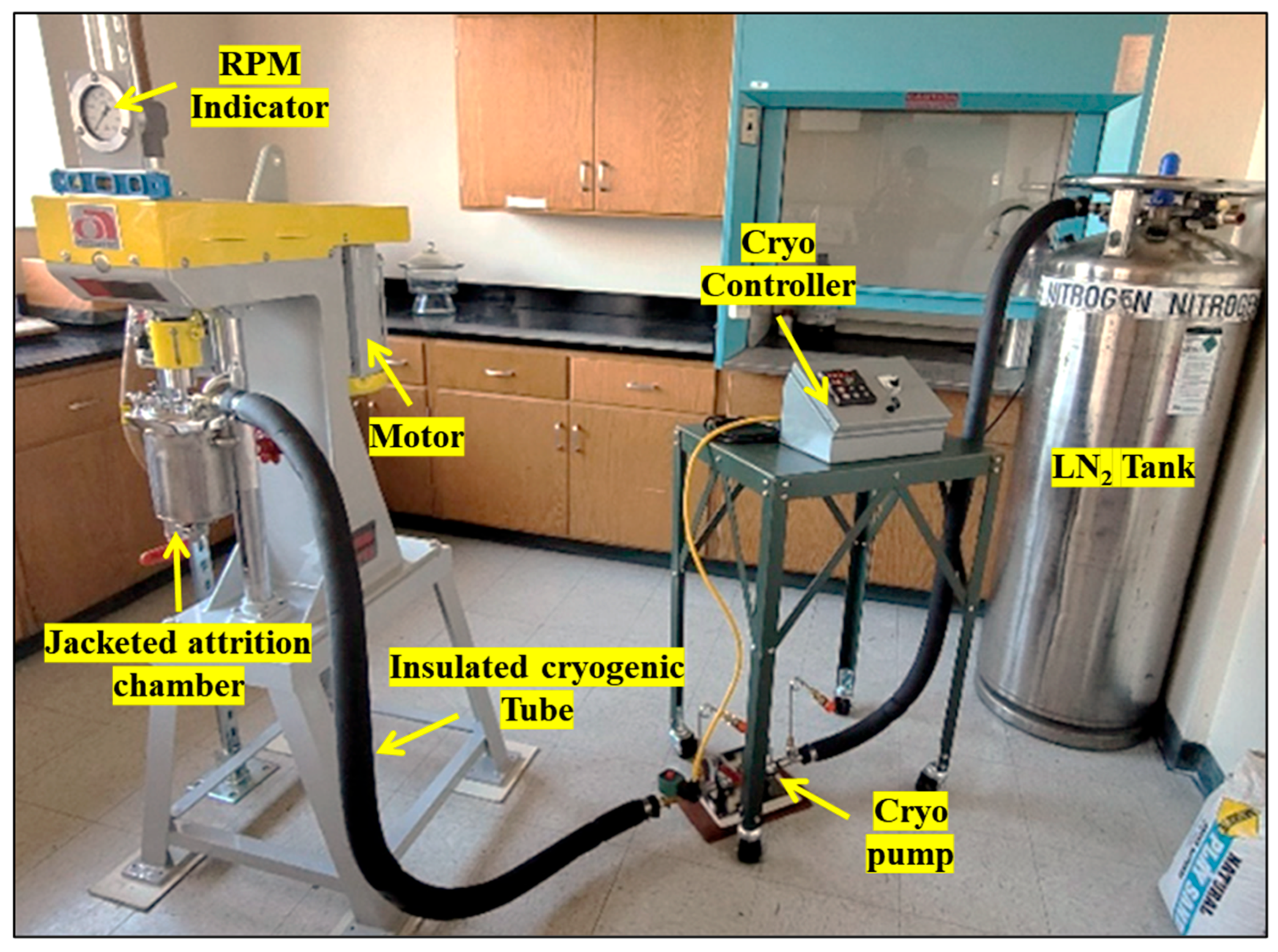
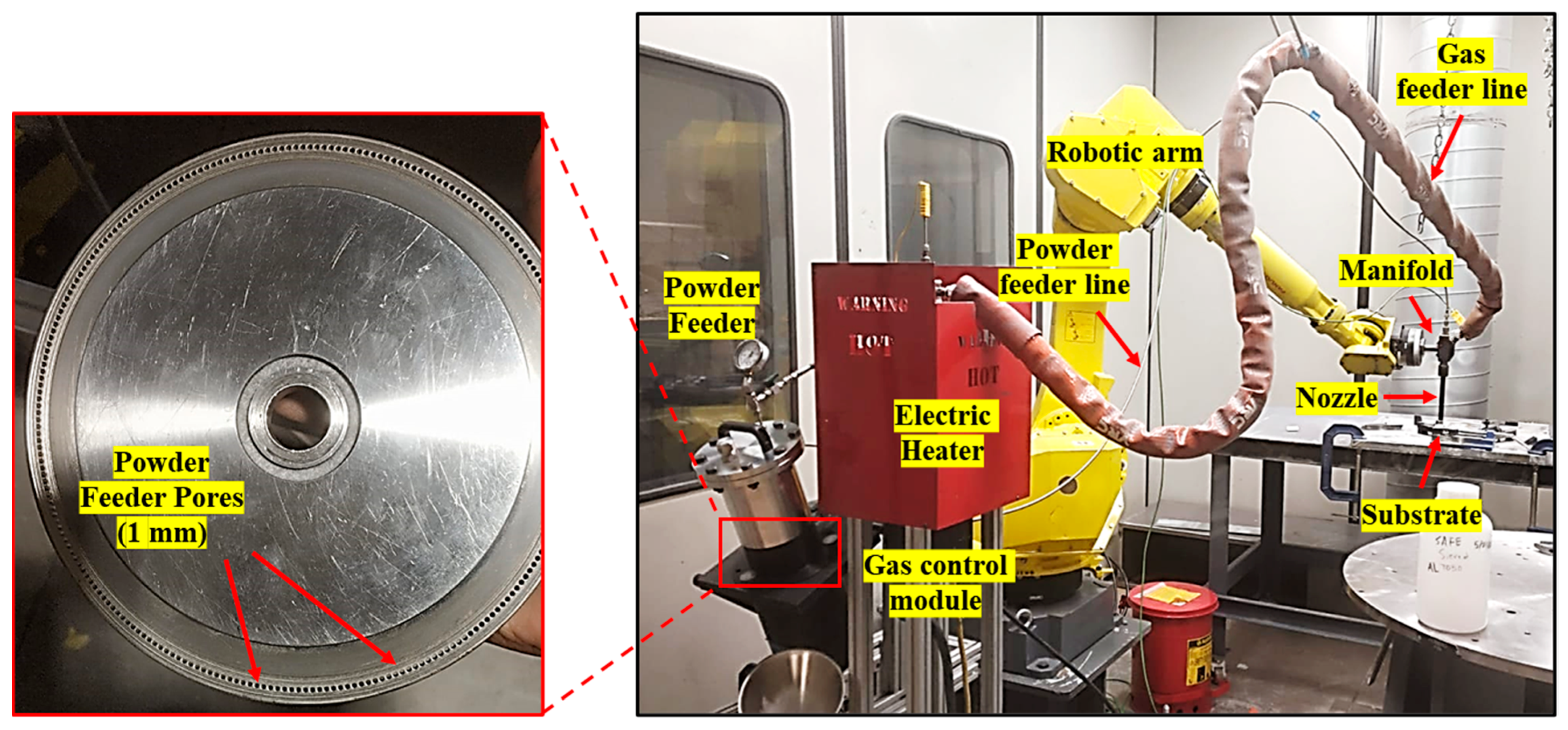


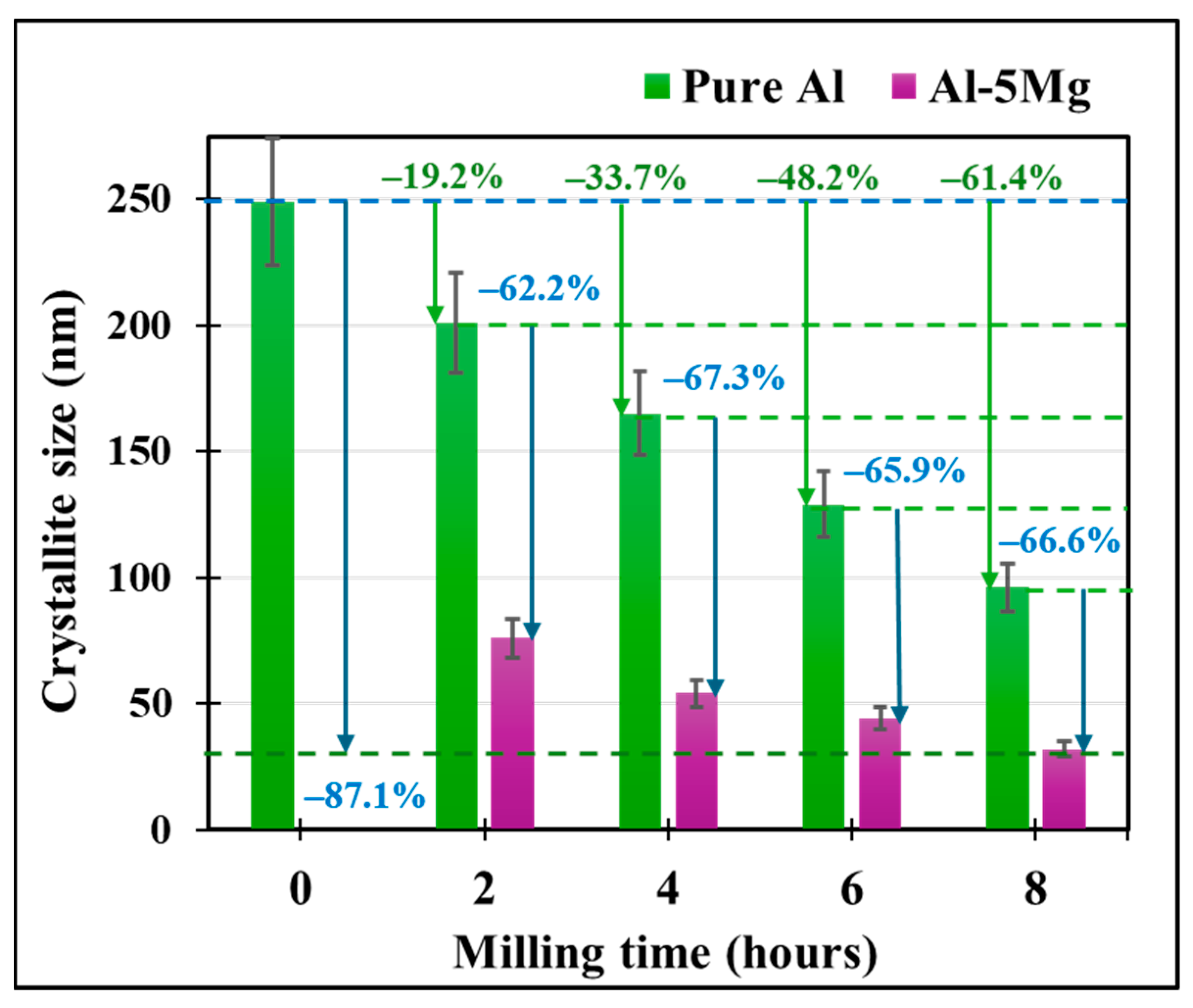
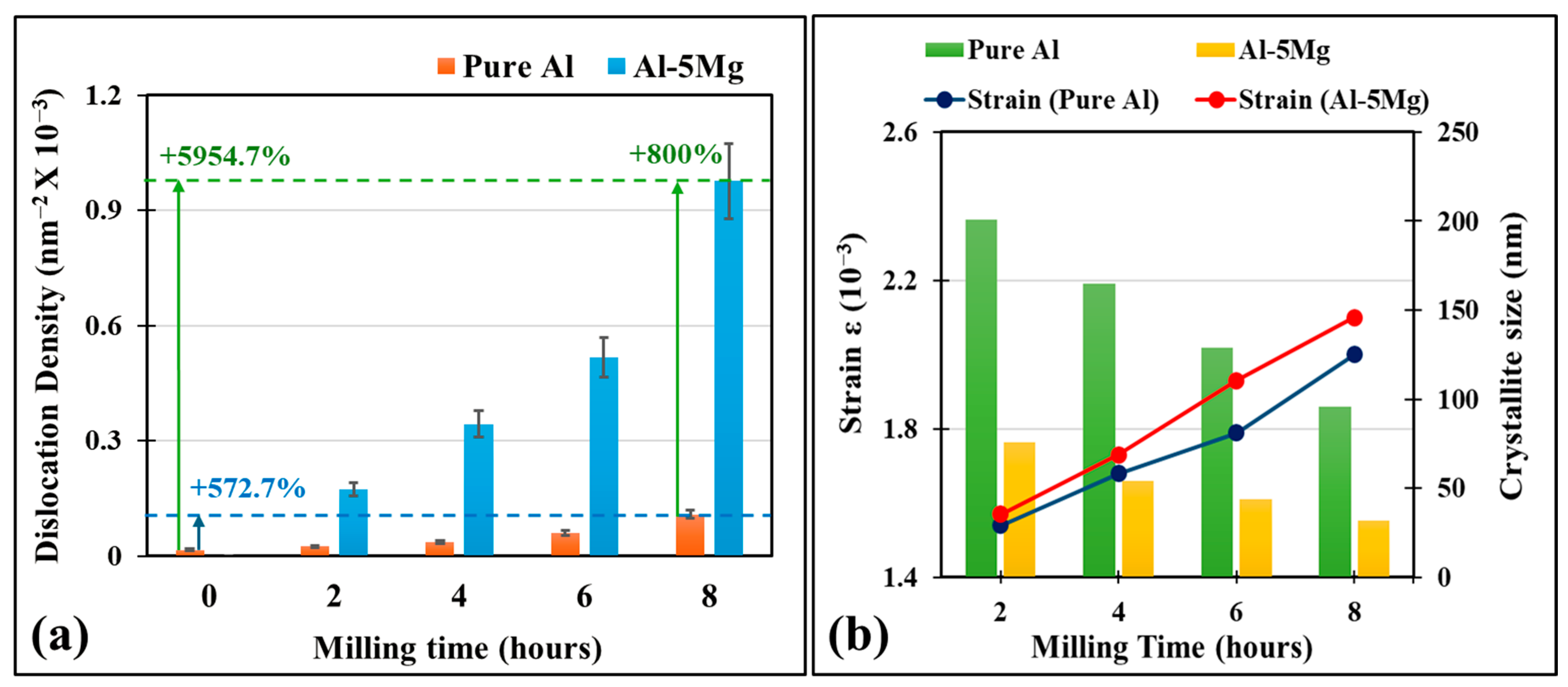
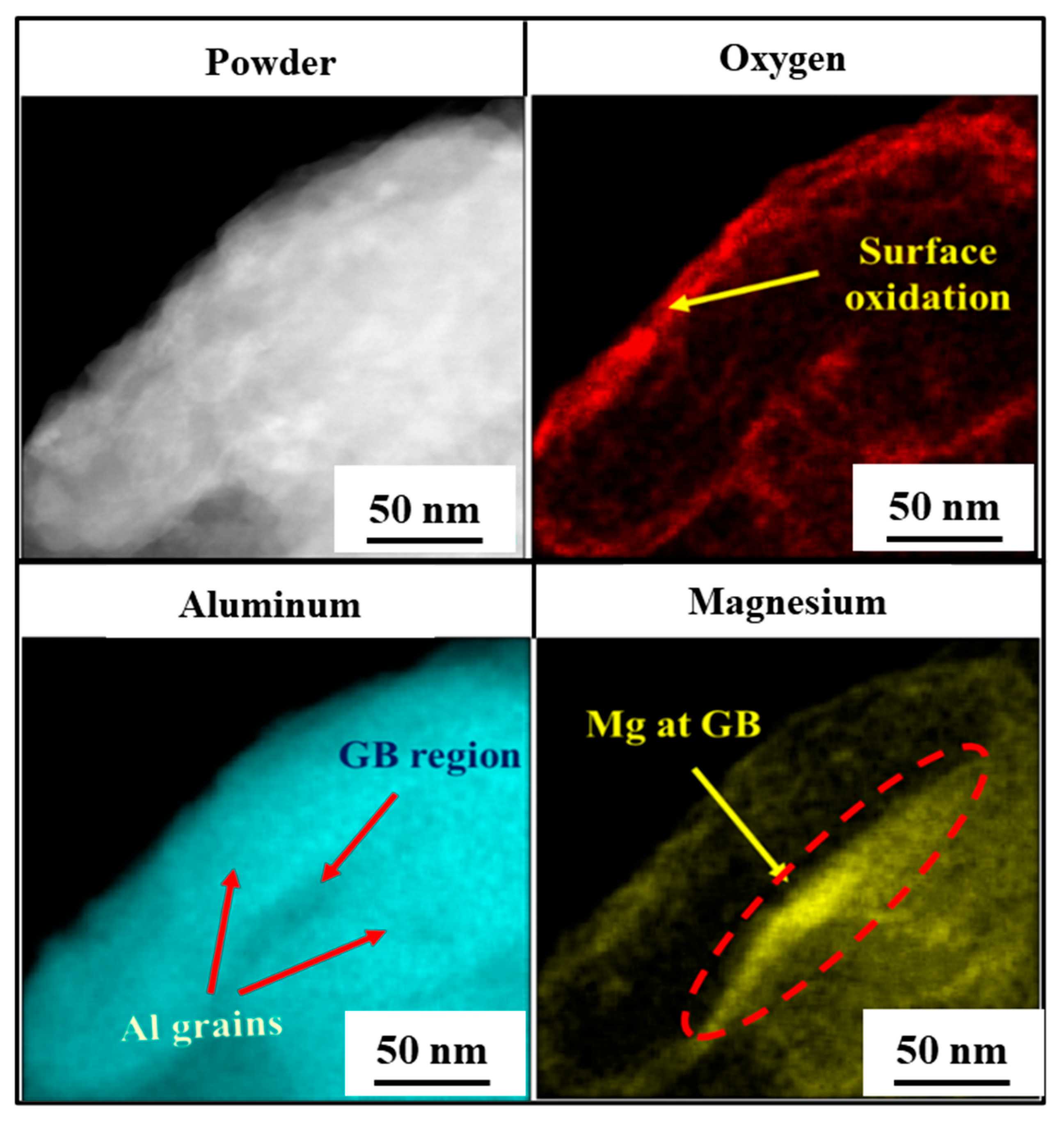


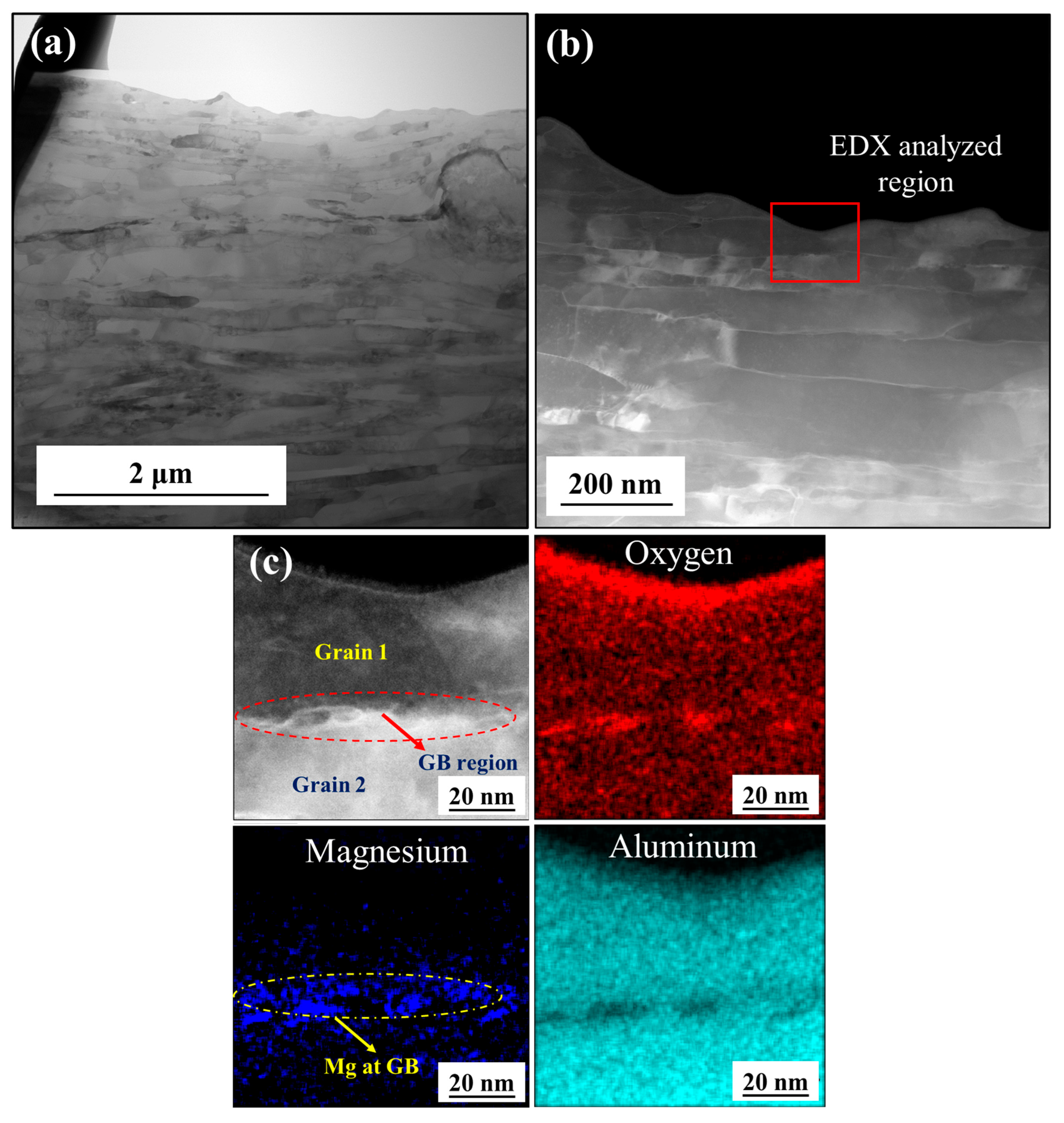


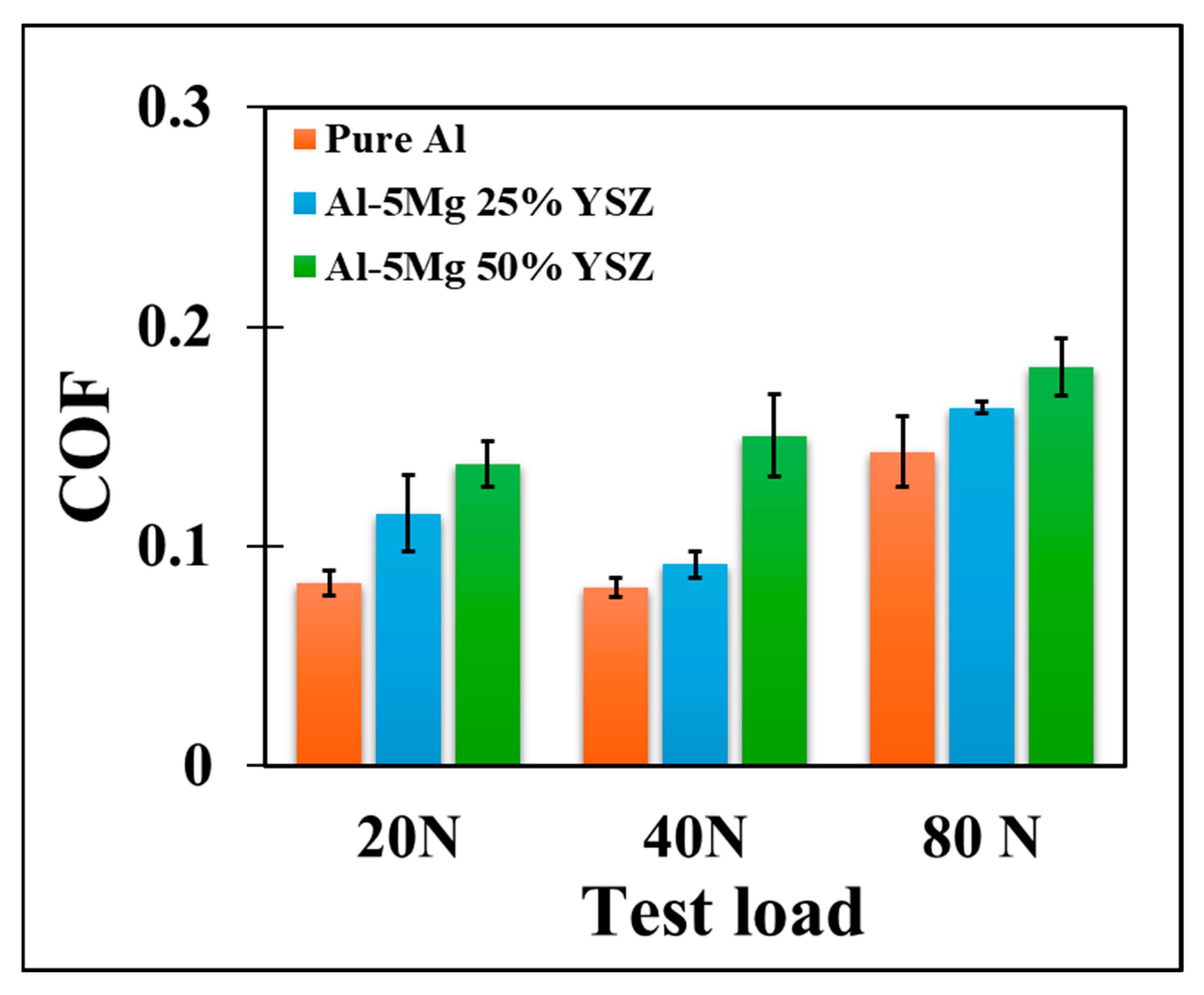

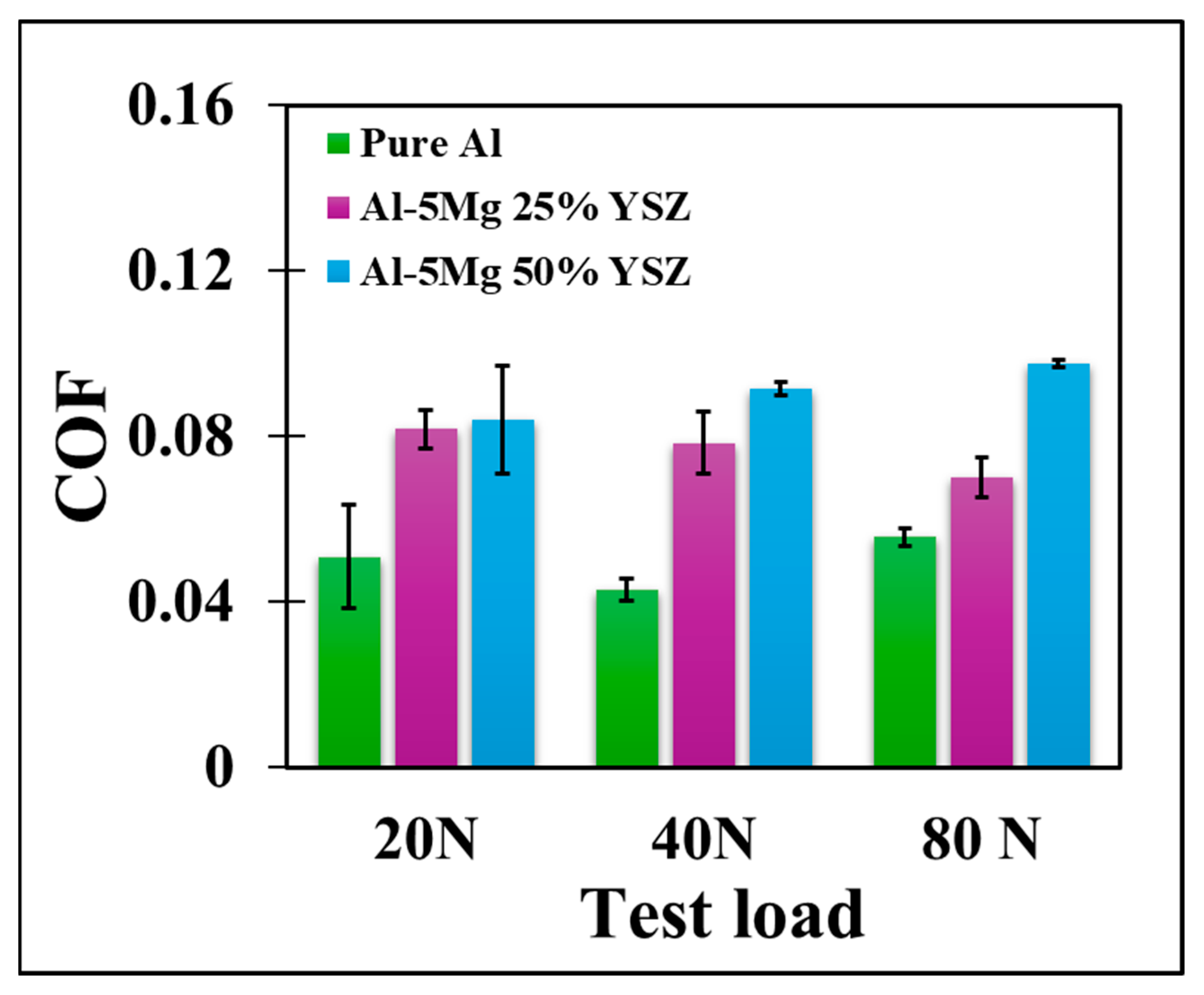
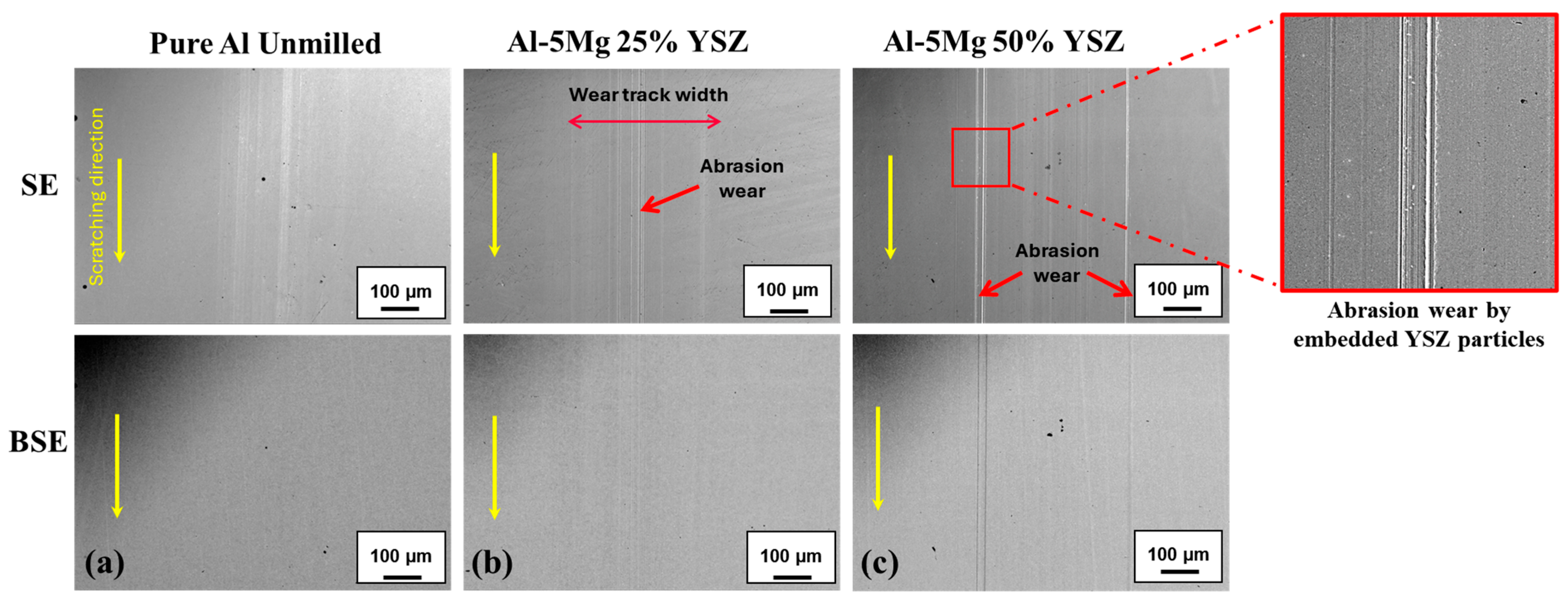
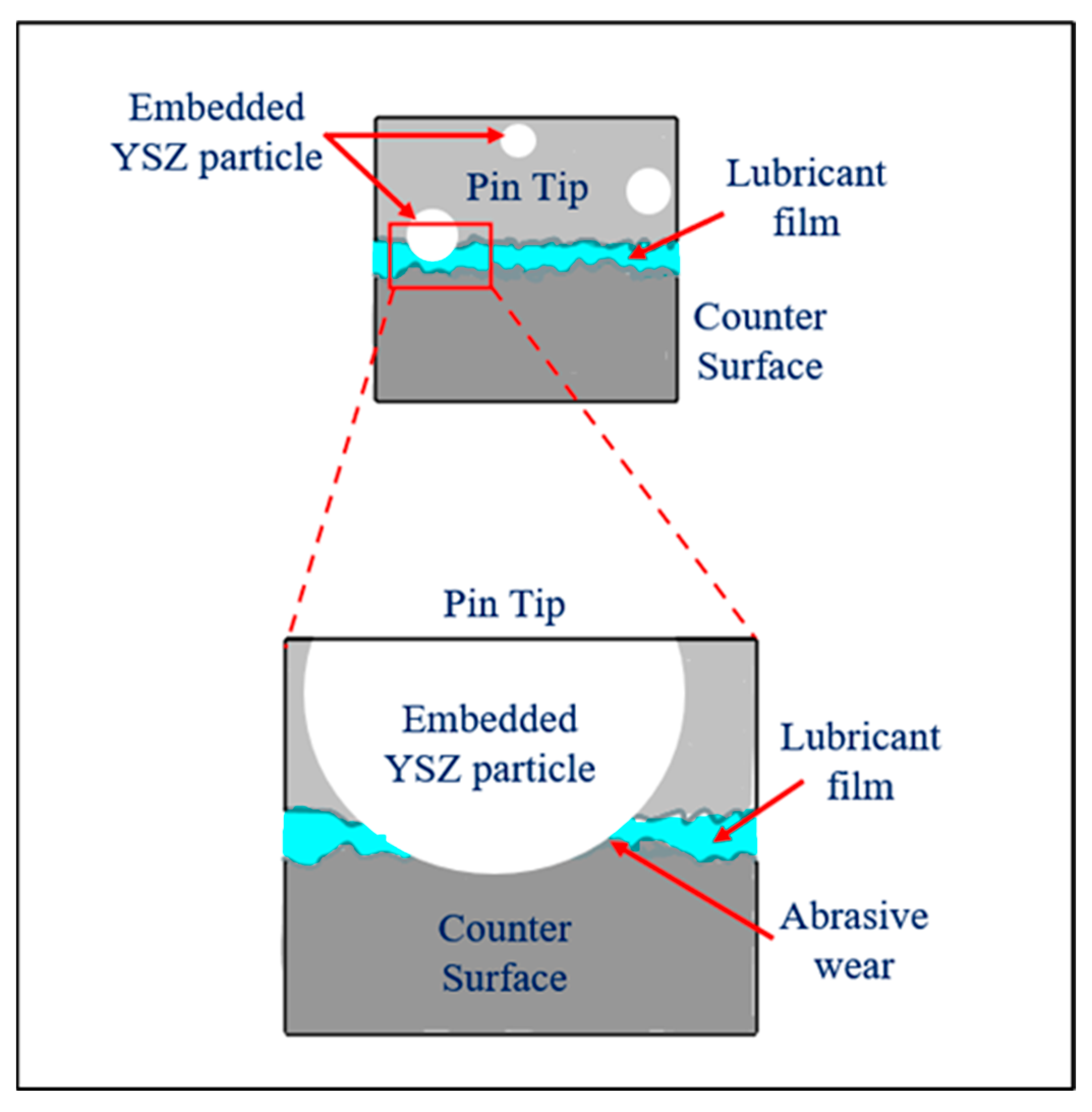
| CS Parameter | Standard Value |
|---|---|
| Substrate | Al 6061 alloy |
| Spray powder | Pure Al and cryomilled Al alloy powders |
| Spray additive (optional) | YSZ |
| Spray pressure | 900 psi |
| Nozzle diameter | 2 to 6.3 mm |
| Spray Velocity | >600 m/sec |
| Spray angle | 90° (Perpendicular to surface) |
| Standoff distance | 15 mm |
| Step size for raster | 1 mm |
| Powder feeder RPM | 12 RPM |
| Powder feeder gas flow | 150 SLM (standard liters per minute) |
| Powder feeder pore size | 1 mm |
| Carrier gas temperature | 400 °C |
| Carrier gas flow | 1715 SLM |
| Pin Sample | Load (N) | Total Wear Volume (×10−3 mm3) | Wear Rate (×10−3 mm3/Nm) | Wear Coefficient (×10−2) |
|---|---|---|---|---|
| Pure Al | 20 | 0.265 | 0.332 | 1.304 |
| 40 | 1.610 | 1.006 | 1.975 | |
| 80 | 4.017 | 1.255 | 1.231 | |
| Al-5Mg 25YSZ | 20 | 0.109 | 0.136 | 1.372 |
| 40 | 0.344 | 0.215 | 1.086 | |
| 80 | 1.235 | 0.386 | 0.974 | |
| Al-5Mg 50YSZ | 20 | 0.042 | 0.053 | 0.560 |
| 40 | 0.174 | 0.109 | 0.572 | |
| 80 | 0.616 | 0.193 | 0.505 |
| Pin Sample | Load (N) | Total Wear Volume (×10−6 mm3) | Wear Rate (×10−6 mm3/Nm) | Wear Coefficient (×10−5) |
|---|---|---|---|---|
| Pure Al | 20 | 1.340 | 1.675 | 6.579 |
| 40 | 4.793 | 2.995 | 5.879 | |
| 80 | 16.581 | 5.181 | 5.084 | |
| Al-5Mg 25YSZ | 20 | 0.204 | 0.255 | 2.579 |
| 40 | 0.786 | 0.491 | 2.477 | |
| 80 | 3.019 | 0.943 | 2.380 | |
| Al-5Mg 50YSZ | 20 | 0.083 | 0.104 | 1.109 |
| 40 | 0.424 | 0.265 | 1.391 | |
| 80 | 2.147 | 0.671 | 1.761 |
| Condition | Friction Mechanism | COF Trend |
|---|---|---|
| Dry, low YSZ | Adhesion-dominated | High COF, increases with load |
| Dry, high YSZ | Mixed: Adhesion + Third-body abrasion (plowing) | Even higher COF, enhanced wear |
| Lubricated, low YSZ | Plowing-dominated, minimal adhesion | Low COF, stable with moderate load |
| Lubricated, low YSZ | Reinforcement-driven micro plowing increases COF | COF increases with load and YSZ content |
Disclaimer/Publisher’s Note: The statements, opinions and data contained in all publications are solely those of the individual author(s) and contributor(s) and not of MDPI and/or the editor(s). MDPI and/or the editor(s) disclaim responsibility for any injury to people or property resulting from any ideas, methods, instructions or products referred to in the content. |
© 2025 by the authors. Licensee MDPI, Basel, Switzerland. This article is an open access article distributed under the terms and conditions of the Creative Commons Attribution (CC BY) license (https://creativecommons.org/licenses/by/4.0/).
Share and Cite
Kushwaha, A.K.; Misra, M.; Menezes, P.L. Mechanical and Tribological Performance of Additively Manufactured Nanocrystalline Aluminum via Cryomilling and Cold Spray. Lubricants 2025, 13, 386. https://doi.org/10.3390/lubricants13090386
Kushwaha AK, Misra M, Menezes PL. Mechanical and Tribological Performance of Additively Manufactured Nanocrystalline Aluminum via Cryomilling and Cold Spray. Lubricants. 2025; 13(9):386. https://doi.org/10.3390/lubricants13090386
Chicago/Turabian StyleKushwaha, Amanendra K., Manoranjan Misra, and Pradeep L. Menezes. 2025. "Mechanical and Tribological Performance of Additively Manufactured Nanocrystalline Aluminum via Cryomilling and Cold Spray" Lubricants 13, no. 9: 386. https://doi.org/10.3390/lubricants13090386
APA StyleKushwaha, A. K., Misra, M., & Menezes, P. L. (2025). Mechanical and Tribological Performance of Additively Manufactured Nanocrystalline Aluminum via Cryomilling and Cold Spray. Lubricants, 13(9), 386. https://doi.org/10.3390/lubricants13090386







